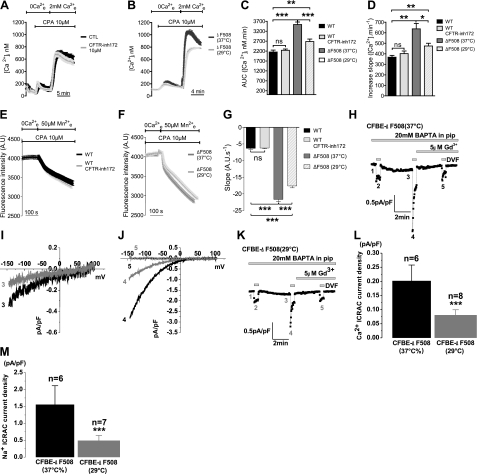Figure 6.
SOCE is reduced when ΔF508-CFTR trafficks to the PM, but does not depend on CFTR channel activity. A) Traces of Ca2+i measured in CFBE-WT cells under control conditions (black trace) and after treatment with the CFTR channel inhibitor CFTRinh172 (10 μM; light gray trace). B) Similar experiment with CFTR-ΔF508 cells under control conditions (gray trace) and after incubation at 29°C for 24 h to correct trafficking of the mutant protein (light gray trace). Traces are means ± se of 14–15 CFBE-WT cells and 20–21 CFBE-ΔF508 cells. C, D) AUC (C) and slope (D) of Ca2+i increase in CFBE-WT (control, black bars; CFTRinh172, dark gray bars) and CFBE-ΔF508 cells (control, gray bars; 29°C, light gray bars). Data are means ± se of 27–44 CFBE-WT cells and 39–58 CFBE-ΔF508 cells. E, F) Rate of Mn2+ quench confirms the dependence of SOCE on correction of ΔF508-CFTR trafficking rather than its channel activity, in both CFBE-WT (E; control, black trace; CFTRinh172, light gray trace) and -ΔF508 cells (F; control, gray trace; 29°C, light gray trace). Traces are means ± se of ∼15 cells/condition. G) Summary of the Mn2+ quenching rate measured in 30–36 CFBE-WT cells and 46–90 CFBE-ΔF508 cells. Orai1-mediated current is lowered when ΔF508-CFTR is trafficked to the PM by low-temperature treatment. H–M) ICRAC is normalized by rescue of ΔF508-CFTR trafficking to the cell surface induced by low-temperature treatment. ICRAC was measured in CFBE-ΔF508 cells cultured at 37°C (H) or at 29°C (K) using the same protocol as described in Fig. 5G–L. I/V curves show that 29°C treatment diminished the Ca2+ ICRAC (I) and the Na+ ICRAC (J) in CFBE-ΔF508 cells compared to those incubated at 37°C and were blocked by 5μM Gd3+ (J). L) Data summary of divalent ICRAC density in CFBE-ΔF508 cells at 37°C (n=6) or 29°C (n=8). M) Data summary of monovalent ICRAC density in CFBE-ΔF508 cells at 37°C (n=6) or at 29°C (n=7).

